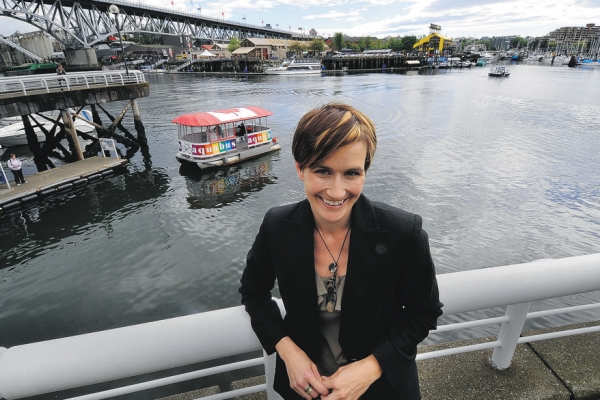Claudia Kwan
Sun

The front porch on the original McGregor home sits on the northern portion of the site. The home will house four apartments above a communal games room and library. Photograph by: Steve Bosch, PNG, Vancouver Sun

A scale model of the McGregor new-home development in Burnaby shows the layout of the 12-acre parcel. Photograph by: Steve Bosch, PNG, Vancouver Sun

The show suite at McGregor. Architect Robert Ciccozzi says elements have been taken from the character home and applied to the townhouses. Photograph by: Steve Bosch, PNG, Special To The Sun

The heritage barn from the early 20th century will remain on the site, while the heritage home will contain four McGregor apartments. Photograph by: Steve Bosch, PNG, Special To The Sun

PHOTOS: CITY OF BURNABY Douglas McGregor and his mother, Margaret, on the stairs to their home, in 1911. A young Douglas McGregor is shown at right on his pony.




Images from the McGregor presentation suite show a home with warm finishes and rich details. Exteriors will be painted in bold colours.
Project name: McGregor
Project location: 4250 Marine Dr., Burnaby
Project size: 36 townhouses in Phase 1; 92 townhouses + 4 condos in total
Residence size: 4-bed 1,625 to 1,655 sq. ft.
Prices: Townhouses from $539,000
Developer: Amacon
Architect: Robert Ciccozzi Architecture.
Interior Design: Portico Design Group
Sales centre: 4250 Marine Dr., Burnaby
Hours: Noon to 6 p.m., Sat to Thur
Telephone: 604-433-4567
Web: www.mcgregorliving.com
Occupancy: Summer/fall 2011
—
When you’re travelling along the road through Burnaby’s Big Bend neighbourhood, you might spot some big box stores, a church and some produce farms.
It takes a considerable craning of the neck — or a slight detour — to find McGregor, Amacon’s latest development.
At the moment, the 12-acre property seems fairly serene. The heritage McGregor house, completed in about 1905, is set back nearly 500 metres from the cars swooshing by on Marine Way. A number of two-storey industrial warehouses, also owned by Amacon, are in a buffer zone near the road. The rumble of traffic is faintly audible from the home’s wide veranda, but it’s surprisingly quiet overall.
Initial work has begun on the site to prepare it for construction. When all three phases of the project are complete, a series of small townhouse buildings (with a total of 96 homes), will dot the landscape, amid a parklike setting of trees and cycling and pedestrian paths. A huge community garden patch will take advantage of the rich boggy soil that produces vegetables for farms just down the street. A stream that serves as fish habitat will wind its way through the property from a large pond to the east of the original house.
The pond and waterways were originally used to move logs to market in the late 19th century, when the site was known as the Royal City Mills logging camp. Now the stream will likely provide hours of amusement and enjoyment for the young families envisioned as the buyers for McGregor.
The home was built for Duncan McGregor and his wife, Margaret, who carved a palatial estate from the original 160-acre parcel, with manicured gardens, a tennis court, fruit orchards and a barn. Their son Douglas grew up riding ponies and horses, rambling on the grounds with pointer dogs, before growing up and attending Burnaby South secondary school.
Duncan McGregor died of cancer in 1928, and the family fell on tough financial times after the Great Depression hit. His widow Margaret leased out the property, but the municipality of Burnaby eventually took it for nonpayment of property taxes.
The provincial government bought the property and used it for decades as a boys’ rehabilitative home known as New Haven. It was ultimately sold to Amacon.
Four apartments will be located in the heritage home, above communal amenities such as a games room and library, and a heritage barn from the early 20th century will also remain on the property.
The first phase is scheduled to be ready for occupancy by the summer or fall of 2011, with the remaining homes ready over the year after that.
It’s the opposite of the trend toward ultra-high density housing seen in so many other urban areas; if you do the math, there’s more than 5,500 square feet of parkland per home on the property.
While maximizing profits by maximizing land use is usually a primary goal in real estate development, Nic Jensen says the idea here is also to sell a specific lifestyle incorporating the spacious outdoor surroundings.
“With all of the green space, it feels like home, but people still get a simple strata lifestyle,” explains the manager of sales and marketing for developer Amacon.
“We wanted it to feel open.”
The development accommodates a commute either east to the Fraser Valley, or west to Vancouver. Jensen believes it provides a hugely livable option for people who aren’t ready or willing to take on a single-family home, at less than $350 per square foot.
“We think it will mostly be young families taking advantage of the price point,” he says. “We’ve even incorporated that into the floor plans. The combined dining area and kitchen looks into an enclosed family room, so you can cook or clean while you’re watching over the kids. It’s the best of both worlds.”
Robert Ciccozzi, principal of Robert Ciccozzi Architecture, wanted to give buyers little details that would help make the homes seem more individual.
“We took elements from the character house and applied it to the townhouses, like little entry shed roofs so that people identify with their own front door,” he says. “We also broke up the roof line with gables and dormers to further identify individual units.”
Some of the homes also have wraparound porches, echoing the heritage home.
Ciccozzi paid homage to the McGregor house, now painted dark green, by using one bold colour for the exteriors of the individual townhouse buildings, including forest green, dark slate blue and brick red, accented by simple white trim.
“They’re not conventional colours, but they look great while being different.
“They’re a bold statement with nice clarity, very presentable.”
Duncan McGregor would probably like the idea of townhouses being developed on the estate he originally named Glen-Lyon.
He had tried to develop the property himself by selling off lots in the 1920s, but the timing wasn’t right.
Amacon is now betting the families of today will see the benefits of having a park outside their front doors.
© Copyright (c) The Vancouver Sun






